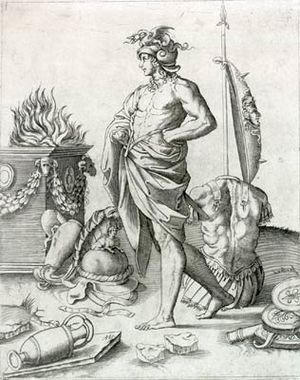Agostino Veneziano facts for kids

Agostino Veneziano (around 1490 – around 1540) was a very important and busy Italian engraver during the Renaissance. His real name was Agostino de' Musi. An engraver is an artist who creates pictures by cutting designs into metal plates. These plates are then used to print many copies of the artwork.
Life of Agostino Veneziano
Agostino Veneziano was born in Venice, a famous city in Italy. He learned his art skills there, but we don't know who his teacher was.
Around 1512 to 1514, he started by copying prints made by other famous artists. These included Albrecht Dürer and Giulio Campagnola. After that, he began making his own artworks. His style was a bit like Campagnola's.
He spent some time in Florence around 1515 and 1516. Then, he moved to Rome, possibly as early as 1514. By 1516, he joined a busy art workshop led by Marcantonio Raimondi. This workshop was a big deal for printmaking. Agostino was one of its most important members.
The workshop stopped working in 1527 because of a big event called the Sack of Rome. During this time, soldiers attacked and looted the city. Many art plates were taken and melted down. But luckily, most of Agostino's plates were saved. This meant his artworks could still be printed years later.
After the Sack of Rome, Agostino went back to Venice. He also visited Mantua and Florence. In 1531, he returned to Rome and stayed there until at least 1536. People believe he died in Rome, but there are no records to confirm this.
Agostino Veneziano was a key artist whose career lasted through a time of big changes. This was when printed art became very popular. It was also when Italian printmaking started to become more like an industry.
Agostino Veneziano's Artworks
Many of Agostino's prints have his special mark, called a monogram. But some do not, which makes it hard to know for sure if they are his. One of his most famous prints is Lo stregozzo, which means The Sorcerers. This artwork is a wild fantasy scene and is quite different from his usual style.
Some of his works are debated between him and Campagnola. Later, some were debated between him and Raimondi or other artists in his group. His art style was not always unique. However, his technique was so good that his work could be confused with those he followed.
The Academy of Baccio Bandinelli from 1531 is another important print. But his prints based on designs by Raphael and Giulio Romano were the most well-known in his time.
His print called The Climbers (1521) shows a part of a drawing by Michelangelo. This drawing was for a huge painting of the Battle of Cascina. The painting was meant for the Palazzo Vecchio in Florence but was never finished. Agostino also made many prints about the story of Psyche. These were based on designs by Michael Coxcie.
His career probably never fully recovered after the Sack of Rome. In Venice, his pictures for a book by Serlio were not used. Still, he kept making prints based on Raphael and Giulio Romano's work in his later years. Sometimes, he made new versions of his older artworks.
In his final years in Rome, he created a series of prints of old vases. These were some of the first pictures of ancient objects. Such images later became very common.
A historian named Johann David Passavant said Agostino made 188 prints. But a new count would likely show even more. About 141 prints have his monogram, and it's believed all of these are truly his.
See also
 In Spanish: Agostino Veneziano para niños
In Spanish: Agostino Veneziano para niños

